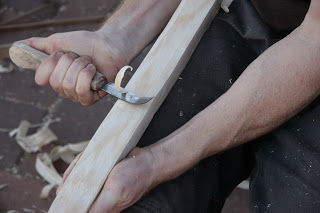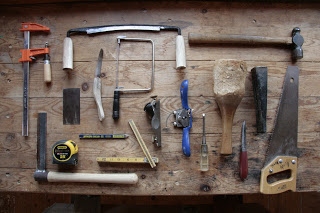
Building Traditional Snowshoes

We call it "Live Craft". Every intern at North House chooses a skill that they want to develop and share with visitors to campus, and we demonstrate our chosen craft one Sunday each month on the commons.
I decided to make snowshoes.
Did I have any experience making snowshoes? No. Have I taken the class that John Beltman teaches at North House? No. Did I consult with John and several other snowshoe makers and an excellent book on the subject and proceed to employ the classic "trial and error" technique? You bet I did.
My current pair on a winter trek.
I have been enamored by snowshoes for years. Such simple implements - strategically shaped wood and webbing, maybe a few pieces of metal to hold it all together - that are perfectly adapted to allow travel across expanses of wintertime land that wouldn't be accessible otherwise. I remember a few winters ago snowshoeing with ease through the backcountry of the Porcupine Mountains and wondering how deep was the snow below me. I stuck my hiking pole handle-first into the surface at my feet and the entire 5 foot pole disappeared. I remember feeling a sense of wonder and appreciation for these humble tools strapped to my feet. Eons of experience encapsulated.
I wanted to be a part of that magic. My mission: to build a pair of snowshoes using only hand tools. I want to learn not only about snowshoe construction but also about working wood with hand tools.
Let it begin! Mike chainsaws the log - the only power tool that touched my shoes.
The tree becomes halves then quarters...
Driving wedges to begin the split.
I was able to get my hands on two pieces of straight-grain, mostly knot-free tree trunks: one was a paper birch and the other a black ash (thanks Mike, Kidds, and Ian!). Black ash bends extremely well and is a commonly used wood, and it was suggested to me that paper birch may have traditionally been used in this region to make snowshoes.
Then eighths, then (maybe) sixteenths.
Step one: riving the log into staves. This means splitting the wood along the grain with wedges and mallet and froe. Maintaining the wood grain, rather than sawing across it, creates a stronger piece of wood that is less likely to crack.
Drawknife work, and peanut butter love.
Using my crooked knife to rough out the shape.
Step two: Shaping the staves down to size. The finished frame pieces are 1/2" inch wide and 3/4" tall and this step involves bringing them down nearly to that size. I used a draw knife and shaving horse, but also practiced using a crooked knife - a traditional tool of the Eastern Woodland native Americans that is essentially a one-handed draw knife.
Step three: Bending the staves in the form. I soaked the staves in hot water then quickly bent them into place on a form. This is an Ojibway style snowshoe - the shoes have pointed tips on both ends.
Frame pieces heated, then bent into the form - black ash.
Step four: Final shaping and smoothing. I used the crooked knife, block plane, spokeshave and cabinet scraper to bring the staves down to their final uniform size and shape, and to smooth the tool marks off.
All the tools I've used so far except the hand drill.
Step five: Mortising for the cross pieces, cutting out the cross pieces, and riveting the ends together. This is when the shoe took on a new, finished, solid quality. Making progress!
Looking forward, I will be weaving the webbing pattern and creating foot bindings.
I find myself continually grateful for this opportunity. My internship has given me access to so many quality tools, great shop space, and most importantly for this project, what seems like the largest concentration of people anywhere in Minnesota who have experience making snowshoes. I have been so glad to hear their ideas.
Steps 1-5 displayed together.
The most beautiful thing about this project for me, certainly beyond creating a useful pair of snowshoes, is the opportunity to learn totally new and foreign skills, partly by advice from experts (why reinvent the wheel?) and partly by using my intuition, body, and mind to teach myself. I believe that there are so many skills that we all hold within us and innately know, despite never learning them in our lifetimes. Call it genetic wisdom or inherited knowledge or whatever you want, but we have generations, centuries, millenia of using our hands to create every part of our lives. It is so exhilarating to tap into that source!









